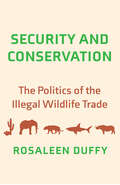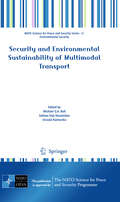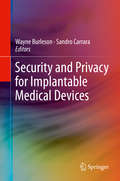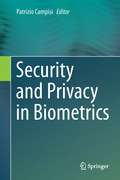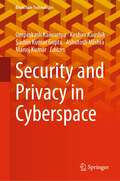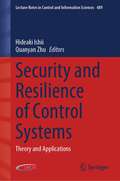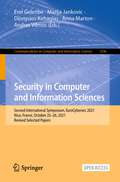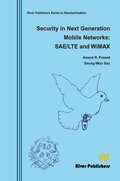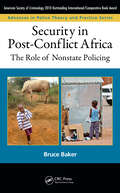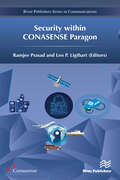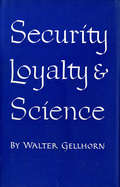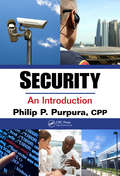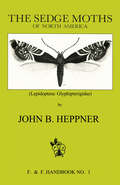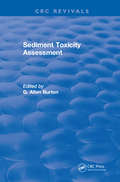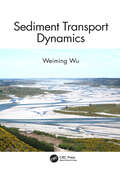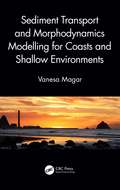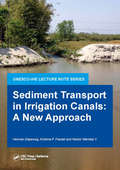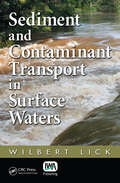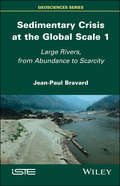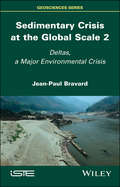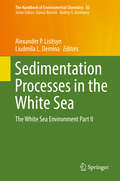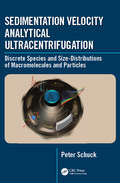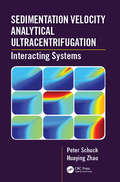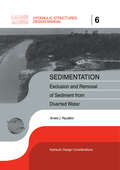- Table View
- List View
Security and Conservation: The Politics of the Illegal Wildlife Trade
by Rosaleen DuffyAn exploration of the scale, practical reality, and future implications of the growing integration of biodiversity conservation with global security concerns &“There are few keener observers of international biodiversity conservation than Rosaleen Duffy. With a ferocity of purpose, she investigates the tenuous connection and nuances among illegal wildlife trade, terrorism threats, and national security.&”—Steven R. Brechin, Rutgers University, New Brunswick Debates regarding environmental security risks have generally focused on climate change and geopolitical water conflicts. Biodiversity conservation, however, is increasingly identified as a critical contributor to national and global security. The illegal wildlife trade is often articulated as a driver of biodiversity losses, and as a source of finance for organized crime networks, armed groups, and even terrorist networks. Conservationists, international organizations, and national governments have raised concerns about &“convergence&” of wildlife trafficking with other serious offenses, including theft, fraud, corruption, drugs and human trafficking, counterfeiting, firearms smuggling, and money laundering. In Security and Conservation, Rosaleen Duffy examines the scale, practical reality, and future implications of the growing integration of biodiversity conservation with global security concerns. Duffy takes a political ecology approach to develop a deeper understanding of how and why wildlife conservation turned toward security‑oriented approaches to tackle the illegal wildlife trade.
Security and Environmental Sustainability of Multimodal Transport
by Michael Bell Solmaz Haji Hosseinloo Urszula KanturskaThis book is the result of a NATO Advanced Research Workshop which was held at Imperial College London in January 2009. It features contributions from a range of international experts covering topics related to the transport of hazardous materials, such as routeing and scheduling, risk assessment, security, and social and environmental exposure. There is also a broad look at the implications of climate change for transport. This unique resource offers a deep understanding of hazardous material transportation and concomitant security and environmental problems. The risks involved in the transport of dangerous goods are shown to arise mainly from the location of the sources and destinations as well as the timing of deliveries. Environmental concerns, including the implications of climate change for transport, provide a useful context for the more analytical material. The book is timely and topical as the subjects covered have become a focus for public concern in recent years, due in part to terrorist attacks on transport systems. This comprehensive reference provides examples from around the world, illustrating the diversity of regulations which apply to the handling and transport of dangerous goods. It also provides interesting insights into the global energy supply chain and describes on-going work on establishing network vulnerability.
Security and Privacy for Implantable Medical Devices
by Sandro Carrara Wayne BurlesonThis book presents a systematic approach to analyzing the challenging engineering problems posed by the need for security and privacy in implantable medical devices (IMD). It describes in detail new issues termed as lightweight security, due to the associated constraints on metrics such as available power, energy, computing ability, area, execution time, and memory requirements. Coverage includes vulnerabilities and defense across multiple levels, with basic abstractions of cryptographic services and primitives such as public key cryptography, block ciphers and digital signatures. Experts from Computer Security and Cryptography present new research which shows vulnerabilities in existing IMDs and proposes solutions. Experts from Privacy Technology and Policy will discuss the societal, legal and ethical challenges surrounding IMD security as well as technological solutions that build on the latest in Computer Science privacy research, as well as lightweight solutions appropriate for implementation in IMDs.
Security and Privacy in Biometrics
by Patrizio CampisiThis important text/reference presents the latest secure and privacy-compliant techniques in automatic human recognition. Featuring viewpoints from an international selection of experts in the field, the comprehensive coverage spans both theory and practical implementations, taking into consideration all ethical and legal issues. Topics and features: presents a unique focus on novel approaches and new architectures for unimodal and multimodal template protection; examines signal processing techniques in the encrypted domain, security and privacy leakage assessment, and aspects of standardization; describes real-world applications, from face and fingerprint-based user recognition, to biometrics-based electronic documents, and biometric systems employing smart cards; reviews the ethical implications of the ubiquity of biometrics in everyday life, and its impact on human dignity; provides guidance on best practices for the processing of biometric data within a legal framework.
Security and Privacy in Cyberspace (Blockchain Technologies)
by Manoj Kumar Omprakash Kaiwartya Ashutosh Mishra Keshav Kaushik Sachin Kumar GuptaThis book highlights the literature and the practical aspects to understand cybersecurity and privacy in various networks and communication devices. It provides details of emerging technologies on various networks by protecting the privacy and security of cyberspace. This book presents state-of-the-art advances in the field of cryptography and network security, cybersecurity and privacy, providing a good reference for professionals and researchers.
Security and Resilience of Control Systems: Theory and Applications (Lecture Notes in Control and Information Sciences #489)
by Quanyan Zhu Hideaki IshiiThis book comprises a set of chapters that introduce various topics pertinent to novel approaches towards enhancing cyber-physical measures for increased security and resilience levels in control systems. The unifying theme of these approaches lies in the utilization of knowledge and models of the physical systems, rather than an attempt to reinvigorate conventional IT-based security measures.The contributing authors present perspectives on network security, game theory, and control, as well as views on how these disciplines can be combined to design resilient, safe, and secure control systems. The book explores how attacks in different forms, such as false data injections and denial-of-service can be very harmful, and may not be detected unless the security measures exploit the physical models. Several applications are discussed, power systems being considered most thoroughly. Because of its interdisciplinary nature—techniques from systems control, game theory, signal processing and computer science all make contributions—Security and Resilience of Control Systems will be of interest to academics, practitioners and graduate students with a broad spectrum of interests.
Security in Computer and Information Sciences: Second International Symposium, EuroCybersec 2021, Nice, France, October 25–26, 2021, Revised Selected Papers (Communications in Computer and Information Science #1596)
by Erol Gelenbe Marija Jankovic Dionysios Kehagias Anna Marton Andras VilmosThis open access book constitutes the thoroughly refereed proceedings of the Second International Symposium on Computer and Information Sciences, EuroCybersec 2021, held in Nice, France, in October 2021.The 9 papers presented together with 1 invited paper were carefully reviewed and selected from 21 submissions. The papers focus on topics of security of distributed interconnected systems, software systems, Internet of Things, health informatics systems, energy systems, digital cities, digital economy, mobile networks, and the underlying physical and network infrastructures.This is an open access book.
Security in Next Generation Mobile Networks: SAE/LTE and Wimax (River Publishers Series In Standardisation Ser.)
by Anand R. Prasad Seung-Woo SeoStarting from voice services with simple terminals, today a mobile device is nothing sort of a small PC in the form of smart-phones. The result has been a huge increase in data-services giving mobile communication access to critical aspects of human society / life. This has led to standardization of SAE/LTE (System Architecture Evolution / Long Term Evolution) by 3GPP and IEEE 802.16e / WiMAX. Together with penetration of mobile communications and new standardization come new security issues and thus the need for new security solutions. This book provides a fresh look at those security aspects, with main focus on the latest security developments of 3GPP SAE/LTE and WiMAX. SAE/LTE is also known as Evolved Packet System (EPS).The intended audience for this book is mobile network and device architects, designers, researchers and students. The goal of the authors, who have a combined experience of more than 25 years in mobile security standardization, architecture, research, and education, is to provide the book?s readers with a fresh and up-to-date look at the architecture and challenges of EPS and WiMAX security.
Security in Post-Conflict Africa: The Role of Nonstate Policing (Advances in Police Theory and Practice)
by Bruce BakerPolicing is undergoing rapid change in Africa as a result of democratization, the commercialization of security, conflicts that disrupt policing services, and peace negotiations among former adversaries. These factors combined with the inability of Africa‘s state police to provide adequate protection have resulted in the continuing popularity of va
Security within CONASENSE Paragon
by Ramjee Prasad Leo P. LigthartSecurity within CONASENSE Paragon describes in particular the cyber security issues in the field of Communication, Navigation, Sensing and Services within the broad platform of CTIF Global Capsule (CGC). This covers future technologies and its enablers, smart cities, crowd computing, reliable and secure communication interface, satellite unnamed air vehicles, wireless sensor networks, data analytics and deep learning, remotely piloted aircraft system and public safety, network neutrality, business ecosystem innovation and so on.
Security, Loyalty, and Science (Cornell Studies in Civil Liberties)
by Walter GellhornBoth sides of a sensitive problem are assessed by Professor Gellhorn in this penetrating analysis of national security and its effect upon scientific progress.The costs and advantages of secrecy in certain areas of science and the conflict between national safety and individual rights in the administration of our federal loyalty program are presented; all the arguments are objectively weighed. The book answers such questions as: Can young scientists be well trained when publication and teaching are not free? Have we gone far enough-or too far-in avoiding "security risks" in important scientific establishments? How does the federal drive against "potentially disloyal" persons actually work? Do "fear of the smear" and crude methods discourage public service by American scientists?This study, a unit of an investigation of control of subversive activities supported by grants from the Rockefeller Foundation, is based upon two years of research and numerous field interviews of scientists, administrators, defense officials, and educators. Security, Loyalty, and Science is a volume in the series Cornell Studies in Civil Liberty, of which Robert E. Cushman is advisory editor.
Security: An Introduction
by Philip P. PurpuraToday, threats to the security of an organization can come from a variety of sources- from outside espionage to disgruntled employees and internet risks to utility failure. Reflecting the diverse and specialized nature of the security industry, Security: An Introduction provides an up-to-date treatment of a topic that has become increasingly comple
Sedentary Behaviour Epidemiology (Springer Series on Epidemiology and Public Health)
by Michael F. Leitzmann Carmen Jochem Daniela SchmidThis book addresses the origins, determinants and magnitude of the global problem of sedentary behaviour, along with concise yet in-depth solutions for tackling it. As a consequence of major technological advances in modern society, many people find themselves in environments characterized by prolonged sedentary behaviour. Building on the contributions of leading experts in the field, the new edition of this book presents updated knowledge about sedentary behaviour, its medical and public health significance, its correlates and determinants, measurement techniques, and recommendations for addressing this behaviour at the individual, community, environmental, and policy level. The book encompasses current research linking the COVID-19 pandemic to increased levels of sedentary behavior, and it covers global and planetary health aspects of sedentary behavior, highlighting sustainable development goals such as health and well-being for all. Applying a cross-disciplinary methodology, the book avoids considering physical activity and sedentary behavior as a single continuum, which potentially hampers progress in confronting widespread levels of sedentariness. Rather, the book helps readers better understand how sedentary and physically active behavior co-occur and how the two behaviours have distinct contributing factors. Building on the contributions of distinguished international experts in the field, this thorough resource is a valuable asset and challenges professionals, researchers, students, and practitioners alike to adopt new strategies and expand their reach.
Sedge Moths of North America: The (Lepidoptera Glyphipterigidae)
by John B. HeppnerRepresents the first comprehensive study of these moths in North America north of Mexico using modern systematic procedures involving assessment of a number of morphological and biological characters in relation to their phylogenetic status. This study also represents a worldwide generic study made in conjunction with the revision of the North American species, primarily to ascertain realistic generic limits and the placement of the various genera once included in the heterogeneous concept of the family. Extralimital genera are noted in a catalog of generic names associated with the Glyphipterigidae.
Sediment Toxicity Assessment
by G.Allen BurtonSediment Toxicity Assessment provides the latest information regarding how to evaluate sediment contamination and its effects on aquatic ecosystems. It presents an integrated ecosystem approach by detailing effective assessment methods, considerations, and effects to each major component of marine and freshwater systems, including the benthos, plankton, and fish communities. The approaches emphasize defining habitat conditions (physical and chemical), toxicant bioavailability, factors influencing toxicity (lab and field), biomarkers, acute and chronic toxicity, study design, collection methods, and EPA management strategies. The book also explains how to integrate the assessments.Sediment Toxicity Assessment will be useful to to all environmental managers, environmental scientists, ecotoxicologists, environmental regulators, aquatic ecologists, environmental contractors and consultants, instructors, students, conservation commissions, and environmental activist organizations.
Sediment Transport Dynamics
by Weiming WuThis book focuses on the fundamentals of sediment transport in surface waters. It covers sediment properties, open channel flows, sediment particle settling, incipient motion, bed forms, bed load, suspended load, total load, cohesive sediments, water-sediment two-phase flows, hyperconcentrated flows, debris flows, wave-induced sediment transport, turbidity currents, and physical modeling. Besides the primary context of river sedimentation, this book extensively covers sediment transport under coexisting waves and currents in coasts and estuaries, hyperconcentrated and debris flows in rivers, as well as turbidity currents in lakes, reservoirs, channels, and the ocean. It includes a chapter on the water-sediment two-phase flow theory, which is considered the basis of many sediment transport models. It introduces some special topics have that emerged in recent years, such as the transport of mixed cohesive and noncohesive sediments, biofilm-coated sediments, and infiltrated sand within gravel and cobble beds. The text merges classical and new knowledge of sediment transport from various sources in English and non-English literature and includes important contributions made by many scientists and engineers from all over the world. It balances the breadth, depth, fundamental importance, practical applicability, and future advancement of the covered knowledge, and can be used as a text and reference book. The chapters are arranged in a useful sequence for teaching purposes. Certain homework problems are prepared, which also highlight the important topics for instructors to select. Solutions to homework problems are available from the author by request.
Sediment Transport and Morphodynamics Modelling for Coasts and Shallow Environments
by Vanesa MagarThis reference for engineers, and graduate students covers sediment transport and morphodynamics modelling in nearshore environments. It presents the fundamentals required for understanding the physics and for setting up numerical models. This book covers hydrodynamics of estuarine and coastal environments, properties of seafloor and estuarine composition, and hydroenvironmental interactions; emphasising the inter-relations of small- and large-scale processes, and short- and large-evolution timescales. The focus is, principally, on the application of shallow-water theory, but some surface wave models, and coupling of shallow-water models with surface waves is also discussed to some extent. The guidance on running regional models and the case studies presented are directed to managed realignment, coastal protection, climate change impacts, and offshore renewables. Key features: Gives a balanced review of this rich interdisciplinary area Bridges practical engineering and research Offers both large- and small-scale application Suits graduate students and researchers as well as consulting engineers Vanesa Magar is a senior researcher and associate professor at the Centro de Investigación Científica y de Educación Superior de Ensenada (CICESE) in Baja California, Mexico. She was formerly a researcher and then a lecturer at Plymouth University, UK.
Sediment Transport in Irrigation Canals: A New Approach (IHE Delft Lecture Note Series)
by Herman Depeweg Krishna P. Paudel Néstor Méndez VSediment transport in irrigation canals influences to a great extent the sustainability of an irrigation system. Unwanted erosion or deposition will not only increase maintenance costs, but may also lead to unfair, unreliable and unequitable distribution of irrigation water to the end users. Proper knowledge of the characteristics, including behaviour and transport of sediment will help to design irrigation systems, plan effi cient and reliable water delivery schedules, to have a controlled deposition of sediments, to estimate and arrange maintenance activities, etc. The main aim of these lecture notes is to present a detailed analysis and physical and mathematical descriptions of sediment transport in irrigation canals and to describe the mathematical model SETRIC that predicts the sediment transport, deposition and entrainment rate as function of time and place for various flow conditions and sediment inputs. The model is typically suited for the simulation of sediment transport under the particular conditions of non-wide irrigation canals where the flow and sediment transport are strongly determined by the operation of the flow control structures. The lecture notes will contribute to an improved understanding of the behaviour of sediments in irrigation canals. They will also help to decide on the appropriate design of the system, the water delivery plans, to evaluate design alternatives and to achieve an adequate and reliable water supply to the farmers.
Sediment and Contaminant Transport in Surface Waters
by Wilbert LickContaminated bottom sediments and their negative impacts on water quality are a major problem in surface waters throughout the United States as well as in many other parts of the world. Even after elimination of the primary contaminant sources, these bottom sediments will be a main source of contaminants for many years to come. In order to determin
Sedimentary Crisis at the Global Scale 1: Large Rivers, From Abundance to Scarcity
by Jean-Paul BravardThe Earth’s oceans are currently undergoing unprecedented changes: rivers have suffered a severe reduction in their sediment transport, and as a result, sediment input to the oceans has dropped lower than ever before. These inputs have varied over millennia as a result of both natural occurrences and human actions, such as the building of dams and the extraction of materials from riverbeds. Sedimentary Crisis at the Global Scale 1 examines how river basins have been affected by the sedimentary crises of various historical epochs. By studying global balances, it provides insights into the profound disruption of the solid transport of fluvial bodies. The book also explores studies of various rivers, from the Amazon, which remains relatively unaffected, to dying rivers such as the Colorado and the Nile.
Sedimentary Crisis at the Global Scale 2: Deltas, A Major Environmental Crisis
by Jean-Paul BravardThe great deltas of the globe have been threatened for several decades but their decline now appears to be inevitable; they are receding and losing the fertility that supports their tens of millions of inhabitants. Our deltas are victims of the dramatic deterioration in the volume of continental sediment brought by rivers to the oceans.By nature, deltas are fragile eco- and geological organisms. For centuries, they have been subject to human actions in the Mediterranean and European world, and today a deep crisis is affecting the great tropical deltas. A chapter is also devoted to concerns facing the Mississippi, an “aging delta of the new world”.Sedimentary Crisis at the Global Scale 2 discusses possible strategies to protect the deltas of the world – or at least adapt them and their dependencies to the changes they face. Several models are possible, including comprehensive protection (such as in the Netherlands) and cautious and respectful opening to the forces of the oceans in an environment-first perspective.
Sedimentation Processes in the White Sea: The White Sea Environment Part II (The Handbook of Environmental Chemistry #82)
by Liudmila L. Demina Alexander P. LisitsynThis book presents a new perspective on the sedimentation processes in the White Sea, based on a multidisciplinary research study conducted between 2001 and 2016. It provides a comprehensive review and discusses the latest research findings on the ecosystem of this sub-arctic zone.The topics addressed include suspended particulate matter as a main source and proxy of the sedimentation processes in the White Sea; vertical fluxes of dispersed sedimentary matter and absolute masses in the White Sea; and the development history and quaternary deposits of the modern White Sea basin. The authors closely examine the abundance and species composition of microalgae associations and the environmental conditions in the bottom sediments of the White Sea, namely, heavy metal accumulation and aliphatic and polycyclic aromatic hydrocarbons. The book ends contain a summary of the key conclusions and recommendations. Together with the companion volume Biogeochemistry of the Atmosphere, Ice and Water of the White Sea: The White Sea Environment Part I, it offers an essential source of information for postgraduate students, researchers, and stakeholders alike.
Sedimentation Velocity Analytical Ultracentrifugation: Discrete Species and Size-Distributions of Macromolecules and Particles
by Peter SchuckA follow-up to the experimental and instrumental aspects described in Basic Principles of Analytical Ultracentrifugation, the volume Sedimentation Velocity Analytical Ultracentrifugation: Discrete Species and Size-Distributions of Macromolecules and Particles describes the theory and practice of data analysis. Mathematical models for the sedimentation process and the evolution of detected signals are developed in a comprehensive framework, jointly with the description of current and historical strategies for how to extract from noisy experimental data the physical parameters of interest, such as size, mass, and shape, composition, and polydispersity of sedimenting particles. The methods are extensively illustrated, and supported with practical applications, as well as cross-references where to find the methods in the public domain software SEDFIT and SEDPHAT. The systems covered are discrete or polydisperse mixtures of sedimenting molecules or particles in dilute solution, such as proteins and other biomolecules and their stable complexes, man-made polymers, and nanoparticles, observed in different optical systems. A useful reference for researchers and graduate students of macromolecular disciplines, these methods form the essential foundation for the analysis of dynamic interacting systems, which are covered in the volume Sedimentation Velocity Analytical Ultracentrifugation: Interacting Systems. Software referenced in the book is available for download at: https://sedfitsedphat.nibib.nih.gov/default.aspx
Sedimentation Velocity Analytical Ultracentrifugation: Interacting Systems
by Peter Schuck Huaying ZhaoAnalytical ultracentrifugation is one of the most powerful solution techniques for the study of macromolecular interactions, to define the number and stoichiometry of complexes formed, and to measure affinities ranging from very strong to very weak and repulsive. Building on the data analysis tools described in the volume Sedimentation Velocity Analytical Ultracentrifugation: Discrete Species and Size-Distributions of Macromolecules and Particles, and the experimental and instrumental aspects in the first volume Basic Principles of Analytical Ultracentrifugation, the present volume Sedimentation Velocity Analytical Ultracentrifugation: Interacting Systems is devoted to the theory and practical data analysis of dynamically coupled sedimentation processes. This volume is designed to fill a gap in biophysical methodology to provide a framework that builds on the fundamentals of the highly developed traditional methods of analytical ultracentrifugation, updated with current methodology and from a viewpoint of modern applications. It will be an invaluable resource for researchers and graduate students interested in the application of analytical ultracentrifugation in the study of interacting systems, such as biological macromolecules, multi-protein complexes, polymers, or nanoparticles.
Sedimentation: Exclusion and Removal of Sediment from Diverted Water (Iahr Design Manual Ser. #6)
by Arved J. RaudkiviThis monograph provides the practising engineer with a concise overview of the methods of water diversion and exclusion or removal of sediment from the diverted water. The emphasis is on flow features and the associated conveyance of sediments.
